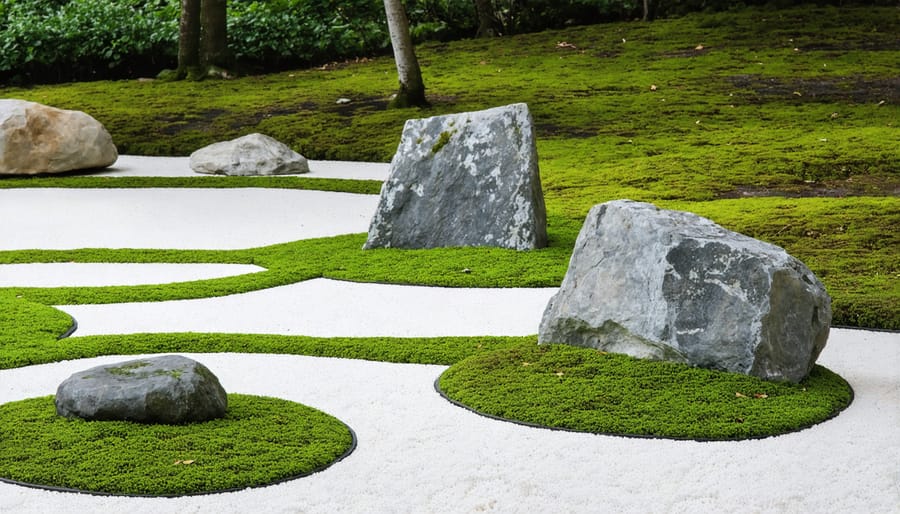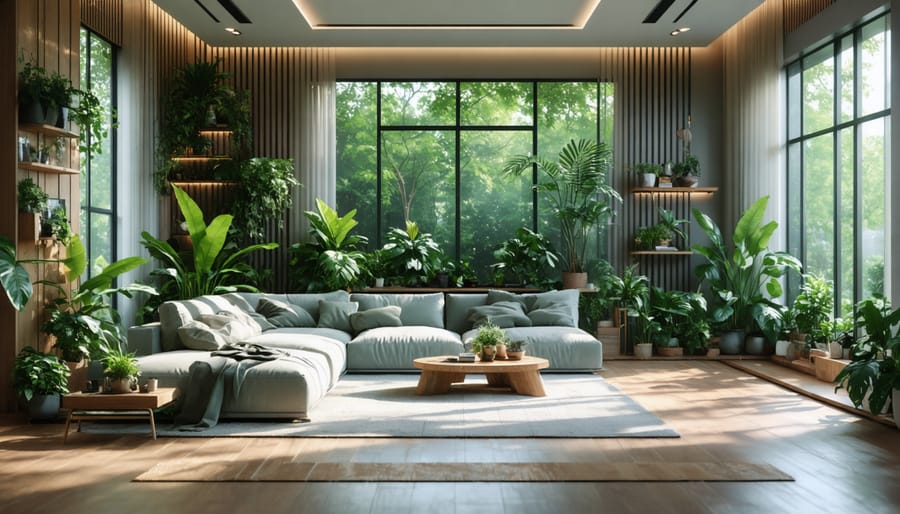Our innate connection to nature runs deeper than mere appreciation – it’s woven into our DNA. The theory of biophilia, first proposed by E.O. Wilson, explains why we feel more alive surrounded by natural elements and why incorporating biophilic design elements into our living spaces isn’t just aesthetically pleasing – it’s essential for our wellbeing. This powerful concept suggests that humans possess an inherent tendency to seek connections with nature and other forms of life, a relationship that modern science has proven boosts creativity, reduces stress, and enhances cognitive function. From the gentle rustle of leaves to the calming presence of natural light, our bodies and minds respond positively to nature’s elements, even in indoor environments. Understanding biophilia isn’t just about appreciating nature – it’s about recognizing how this ancient connection can transform our modern living spaces into sanctuaries that nurture both body and soul.
The Science Behind Biophilic Design
Our Ancient Connection to Nature
Our connection to nature isn’t just a modern trend – it’s deeply woven into our evolutionary story. For millions of years, our ancestors lived in close harmony with the natural world, developing instincts and preferences that still influence us today. Think about how peaceful you feel when listening to birds chirping or watching leaves dance in the breeze – these aren’t random reactions, but rather inherited responses from our past.
Our brains are still wired to respond positively to natural elements, just as they did when we relied on nature for survival. The sight of flowing water still calms us because it once meant life-sustaining drink. The presence of plants still makes us feel secure because they once signaled food and shelter. Even our color preferences often lean toward earth tones and blues, reflecting the landscapes our ancestors called home.
This deep-seated connection explains why we feel more focused in rooms with natural light, more relaxed in spaces with organic materials, and more creative when surrounded by plants. It’s not just preference – it’s part of our genetic makeup.
Modern Research Supporting Biophilic Design
Recent research continues to validate the powerful connection between nature and human wellbeing. A groundbreaking 2019 study by the University of Michigan found that just 20 minutes of contact with nature significantly reduces stress hormone levels. Similarly, researchers at Harvard discovered that offices incorporating natural elements saw a 15% increase in employee productivity and a 26% boost in creativity.
These findings extend to our homes too. A 2021 study revealed that people living in spaces with natural light, plants, and organic materials reported 35% lower anxiety levels and better sleep quality. Even simple elements like nature-inspired artwork or the sound of flowing water have been shown to reduce blood pressure and improve mood.
What’s particularly exciting is how modern technology is helping us measure these benefits. Brain scanning studies have confirmed that viewing natural patterns triggers the same positive responses as being in nature itself. This scientific backing has led to a surge in biophilic design adoption, with architects and interior designers increasingly incorporating these principles into their work to create healthier, more engaging spaces.

Cultural Interpretations of Nature in Design
Eastern Perspectives
Eastern cultures have long embraced a deep connection with nature, particularly evident in their architectural and design philosophies. In Japan, the concept of biophilia is beautifully expressed through Japanese design principles like “shakkei” (borrowed scenery) and “engawa” (transitional spaces between indoors and outdoors). These elements create a seamless flow between living spaces and the natural world, promoting harmony and well-being.
Chinese feng shui similarly emphasizes the importance of natural elements and their influence on human health and happiness. The practice incorporates the five elements – wood, fire, earth, metal, and water – to create balanced environments that nurture both body and spirit. Traditional Chinese gardens exemplify this philosophy, featuring carefully arranged rocks, water features, and plants that mirror natural landscapes in miniature.
Both cultures share a profound respect for natural materials, favoring elements like bamboo, wood, and stone in their designs. They also emphasize the importance of natural light and airflow, often incorporating sliding doors and screens that can be adjusted to welcome nature’s elements into living spaces.
These Eastern perspectives on biophilia offer valuable lessons for modern design, showing how we can create spaces that honor our innate connection to nature while maintaining functionality and aesthetic appeal. Their time-tested approaches demonstrate that biophilic design isn’t just about adding plants to a room – it’s about creating meaningful connections between indoor spaces and the natural world.

Western Interpretations
In Western societies, biophilic design has evolved into a sophisticated blend of natural elements and modern architecture. European interpretations often emphasize the connection between indoor and outdoor spaces through large windows, living walls, and natural materials like wood and stone. Scandinavian design, in particular, has embraced biophilia through its characteristic minimalism combined with abundant natural light and organic textures.
American approaches to biophilic design typically focus on creating urban oases within bustling city environments. Notable examples include New York’s High Line park and Amazon’s Spheres in Seattle, which demonstrate how natural elements can be integrated into commercial and public spaces. In residential settings, Western homeowners increasingly incorporate features like indoor gardens, natural ventilation systems, and materials that mimic natural patterns.
The wellness movement has significantly influenced Western interpretations of biophilia, with designers and architects prioritizing spaces that reduce stress and improve mental health. This has led to innovations like circadian lighting systems, which adjust throughout the day to match natural light patterns, and the integration of water features that create calming soundscapes.
Contemporary Western designers often combine traditional biophilic elements with sustainable technology. Green roofs, solar panels, and smart environmental controls are frequently integrated with natural materials and vegetation, creating spaces that are both environmentally conscious and nature-connected. This modern interpretation reflects a growing understanding that biophilic design isn’t just about aesthetics – it’s about creating healthier, more sustainable living environments that benefit both people and the planet.

Practical Applications in Modern Homes
Natural Materials and Textures
Natural materials and textures play a vital role in creating a biophilic connection within our living spaces. By incorporating elements like wood, stone, and other organic materials, we can forge a stronger link to nature and enhance our overall well-being.
Wood stands out as one of the most versatile and accessible natural materials. Whether it’s exposed wooden beams, hardwood flooring, or furniture pieces with visible grain patterns, wood brings warmth and authenticity to any space. Consider using reclaimed wood for added character and sustainability, or opt for bamboo as a rapidly renewable alternative.
Stone elements add a grounding presence to your environment. From slate floor tiles to river rock accents in bathrooms, stone materials create a sense of permanence and connection to the earth. Even small touches, like a collection of smooth pebbles or a granite countertop, can make a significant impact.
Other organic materials worth incorporating include:
– Natural fiber textiles like cotton, wool, and jute
– Woven grass or reed elements in baskets and rugs
– Cork flooring or wall panels
– Ceramic and clay pieces with earthen textures
When selecting these materials, aim for minimal processing and treatments to maintain their natural characteristics. The subtle variations in color, texture, and pattern that occur in natural materials help create a more authentic and engaging environment. Remember that even small additions of these elements can significantly enhance your space’s biophilic qualities.
Living Elements
Living elements are the heart of biophilic design, bringing the essence of nature directly into our indoor spaces. The most impactful way to embrace this principle is by incorporating living plants throughout your home. From dramatic floor-standing plants like fiddle leaf figs to cascading pothos on shelves, each green addition helps purify the air while creating a visual connection to nature.
Water features add another dynamic dimension to biophilic spaces. The gentle sound of flowing water from a tabletop fountain or wall-mounted water feature can mask urban noise while creating a calming atmosphere that mimics natural streams or rainfall. These elements not only provide sensory stimulation but also help maintain optimal humidity levels indoors.
When selecting plants and water features, consider their placement carefully. Position plants where they’ll receive appropriate light and create natural sight lines throughout your space. Water features work best in areas where you spend time relaxing, such as living rooms or meditation spaces. Remember that even small additions, like a collection of succulents or a modest desktop fountain, can significantly impact your connection to nature and overall well-being in your home environment.
Natural Light and Views
The connection between our indoor spaces and the natural world outside is fundamental to biophilic design, with natural light in design playing a crucial role. Large windows, skylights, and glass doors not only flood our spaces with sunlight but also create a seamless visual connection to the outdoors, reducing the feeling of being confined within four walls.
To maximize this connection, consider positioning furniture to face windows and keeping window treatments minimal. Strategic mirror placement can help bounce light deeper into your space, creating a brighter, more uplifting environment. Remember that natural light isn’t just about aesthetics – it helps regulate our circadian rhythms, improving sleep patterns and overall well-being.
Views of nature, even if just of a small garden or distant trees, can significantly impact our mental state. If your immediate surroundings lack greenery, consider creating a window garden or positioning plants near windows to create your own natural view. For rooms with limited window access, consider installing clerestory windows or light tubes to bring in natural light from above.
The key is to think beyond just having windows – it’s about creating meaningful connections to the outdoor environment that engage our senses and remind us of our inherent bond with nature. Even small changes, like rearranging furniture or trimming outdoor vegetation that blocks light, can significantly enhance your space’s biophilic qualities.
Bridging Cultural Design Differences
Creating a home that embraces biophilic design doesn’t mean you have to stick to just one cultural approach. Today’s modern homes can beautifully blend different cultural interpretations of nature-inspired design, creating spaces that are both personally meaningful and universally appealing.
Japanese design principles, for instance, emphasize the beauty of simplicity and raw materials. You can incorporate these elements through exposed wooden beams, sliding paper screens, or a small indoor rock garden. Meanwhile, Mediterranean approaches celebrate natural light and indoor-outdoor flow, which you can achieve with large windows, terracotta materials, and abundant plant life.
Scandinavian biophilic design focuses on maximizing natural light and using light wood tones, while incorporating cozy natural textiles. This can be blended with Middle Eastern traditions of geometric patterns inspired by natural forms and internal courtyards that bring greenery into the heart of the home.
To successfully bridge these different approaches, start by identifying the core natural elements that resonate with you from each culture. Perhaps you love the water elements common in Balinese design but also appreciate the minimalist wood details of Japanese interiors. These can be combined through a simple wooden soaking tub or a streamlined indoor fountain.
Consider these practical ways to blend cultural approaches:
– Use natural materials native to different regions, like bamboo alongside oak
– Combine different cultural plant selections in your indoor garden
– Mix textile patterns from various traditions that share nature-inspired motifs
– Create transitional spaces that reflect multiple cultural interpretations of indoor-outdoor living
Remember that successful cultural blending in biophilic design isn’t about randomly mixing elements, but rather finding harmonious ways to celebrate different cultural perspectives on our connection with nature. The key is to create a space that feels authentic to your personal experience while honoring the diverse ways humans have traditionally incorporated nature into their living spaces.
The theory of biophilia reminds us that our connection with nature isn’t just a preference – it’s a fundamental human need. By incorporating natural elements into our living spaces, we can create environments that promote wellbeing, reduce stress, and enhance our quality of life. Whether you start small with a few houseplants and natural textures, or embark on larger projects like living walls and natural lighting solutions, every step toward biophilic design is an investment in your home and health. Remember that biophilic elements can be adapted to any space, budget, or lifestyle. Take inspiration from different cultures, experiment with various natural elements, and discover what resonates best with your personal style. Your journey toward a more nature-connected home starts with a single green addition – why not begin today?
